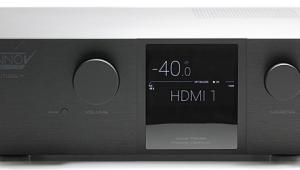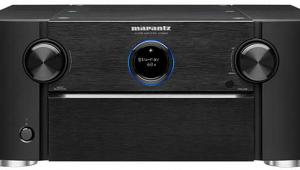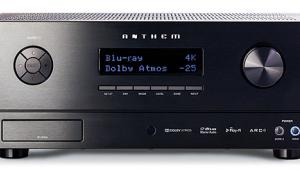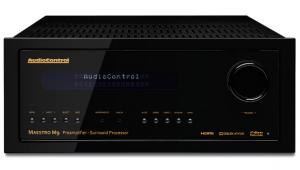Classé SSP-300 Surround Processor and CA-5100 Amplifier
Even before you hear Classé's new Delta series of electronics, you'll probably want to do what I did—feel them up. This is not just because their curved aluminum-and-steel chassis are exquisite works of industrial art—your fingertips wield extraordinary control over the SSP-300 surround processor. The matching CA-5100 five-channel power amplifier will supply the muscle to make your home theater roar.

Have-It-Your-Way Sound
High-end surround processors sporting video displays aren't new, but the touchscreen-controlled SSP-300's LCD is the first of its kind. It has just three hard buttons—Standby, Menu, and Mute. Endlessly configurable virtual buttons appear on the touchscreen. My wife Robin mostly listens to Sirius satellite radio, so all she has to do is hit the button I labeled "Robin" to hear music from space. She loves the SSP-300 because it's the first pre/pro I've tested that doesn't require her to decipher audio lingo or worry about messing something up. I love the SSP-300 because I can calibrate it to sound great in up to four listening positions in my home theater. I set it up for the sweet spot on the couch, my desk a few feet behind the couch, and a comfy chair over by the window. The volume control can accommodate family members' individual preferences: I want the volume to ramp up or down at a certain speed, but Robin wants a slower reaction time so she can easily fine-tune the volume. All of that and much more is so seamlessly programmed into the user interface that even my technophobic mother-in-law watched Cinderella Man without my assistance. Ergonomically elegant, the SSP-300 is truly in a class by itself.
The logistics of programming the touchscreen's controls are fairly straightforward, but I assume that most buyers will rely on their dealer or installer to configure the system. You can archive their carefully honed settings so, if you ever want to get in there and fool around for yourself, you won't lose the dealer's settings. Classé supplies a full-size, metal-bodied microphone for use with the SSP-300's auto calibration system. It certainly looks a lot more serious than the plastic mikes you get with even high-end receivers.
The touchscreen is an updateable feature and distinguishes the SSP-300 from other pre/pros. Sure, you can fully integrate these Classé components with a Crestron or AMX automated control system. As proof that Classé hasn't neglected the audio side, the SSP-300's innards contain Motorola 32-bit processors and eight differential 24-bit digital-to-analog converters to ensure the highest audio resolution.
The cast-metal remote control has a decidedly purposeful feel. The fully backlit design and minimal button count were designed for ease of use, so the remote isn't programmable. If you want whole-system control, go ahead and buy an all-singing, all-dancing universal remote, but never, ever misplace its user manual. Chances are, you'll need it.
HDMI switching is conspicuously absent from the SSP-300's otherwise vast connectivity suite, but Classé has a solution in the form of their CDP-300V DVD player ($7,500). It sports HDMI outputs, along with 1080p/i upscaling and switching for component and S-video sources. Classé's engineers are developing an ultrahigh-end surround processor, the SSP-900, which will incorporate HDMI switching. The SSP-600 ($6,500) is a near clone of the SSP-300 but offers a bevy of balanced XLR inputs and outputs.
 Classé's First-Class Power Amp, the CA-5100
Classé's First-Class Power Amp, the CA-5100
The matching five-channel amplifier, the CA-5100, is a comparatively straight-ahead design. You can attribute a large proportion of its 75-pound weight to its massive, custom-designed power transformer. To ensure the best performance possible, the transformer has three secondary windings, feeding separate power supplies for the left front and surround, right front and surround, and center-channel audio circuits. Classé's engineers replaced the internal fuses and DC blocking caps commonly used in other amps to protect loudspeakers with what they claim to be less sonically invasive control circuits. The amplifier's 100-watt-per-channel output stages are Class A biased to about one-third of the total output power. So, when the CA-5100 is maxed out, the first 30 watts will be Class A watts, which eliminates switching distortion. Did I lose you? That tech talk explains the CA-5100's sweet and transparent sound. If you're using a seven-channel surround system, team the CA-5100 with Classé's matching CA-2100 stereo amp ($3,500). Don't for a second let their 100-watt-per-channel ratings lead you to underestimate just how powerful these amplifiers really are. They can rock!
The SSP-300, the CA-5100, CA-2100, and any Classé component can communicate with each other via CAN-Bus ports. For example, if you press Play on a Classé CD or DVD player, the SSP-300 will automatically select that input. You can monitor your CA-5100's operational status from the SSP-300's LCD screen and keep track of the amp's operating temperature, line voltage, and ground phase—plus, if the amp's protection circuit trips, the amp will generate a message describing the possible cause of the problem.
High Definition for Ears
The first thing you notice about the Classé's sound is its precision. The focus is tighter, bass definition is unusually articulate, vocals have an uncanny naturalness, the treble is super detailed, and yet it's not bright. Transparency is one of the most overused audiophile buzzwords, so I rarely use it, but there's no better one-word description of Classé's sound.
The Classés' deft handling of the music's natural flow on the Alison Krauss & Union Station Live DVD was a total pleasure. As I watched the video, I noted that Krauss' fiddle and all of the guitars, the mandolin, the dobro, and the stand-up bass were individually miked from a short distance (instead of the usual attached pickups). The Classé components revealed those sorts of nuanced but important subtleties. I've played this DVD on lots of other systems, but no other sounded as pure. There was an effortless quality to the sound coursing through the Basie Big Band CD, recorded in 1975. Count Basie's swinging brass section is wonderfully brassy, without a hint of glare or edge.
I'm a huge fan of the Lost TV series, and the boxed set of the first season sounds awesome. The opening scene where Jack regains consciousness in the jungle and stumbles back to the crash site gets my heart pounding. The airliner's jet engine is still roaring amid the screams and panic of the other passengers. The series sound design mixes visceral realism with an abstractly unnerving orchestral score. Yes, I pummeled the Classés with a stack of action flicks (all DVDs with Dolby Digital 5.1 soundtracks) and came away impressed by their power and finesse. Bass oomph never faltered and was, in fact, supremely pitch accurate. Moving up to the honest-to-God high-resolution music encoded onto Roxy Music's Avalon SACD was an even richer feast for my ears. The 360-degree surround mix was totally coherent, and the system mapped out the music's little percussive filigrees with startling precision.
Classé's home theater customers are typically drawn from two camps: serious audiophiles who recently bought an HDTV, and experienced home theater buyers who would like to balance high-definition video with great sound. The SSP-300 and CA-5100 will more than satisfy both groups of lucky buyers.
* Mark Fleischmann's book Practical Home Theater is available through www.quietriverpress.com.
Highlights
• The touchscreen interface is oh so cool
• Impeccable high-end build quality
• Highly transparent sound
- Log in or register to post comments






























































